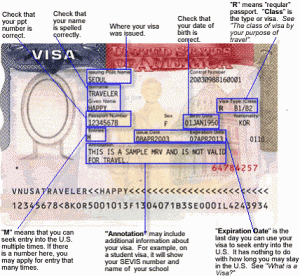The schematic of a U.S. entry visa (below) shows where to find information useful in determining the correct tax treatment of the visa holder. (Illustration from the U.S. Department of State website, visa FAQ)
 First, a puzzling entry: the letter ‘R’ printed below the words ‘Visa Type/ Class. It does not speak about the visa. It says the passport is a Regular passport, not one for someone travelling as an Official, or a Diplomat, or a family member of an official or diplomatic traveler. Visa Type/Class is shown to the right of the passport indicator (usually R), and below the words Type/Class.
First, a puzzling entry: the letter ‘R’ printed below the words ‘Visa Type/ Class. It does not speak about the visa. It says the passport is a Regular passport, not one for someone travelling as an Official, or a Diplomat, or a family member of an official or diplomatic traveler. Visa Type/Class is shown to the right of the passport indicator (usually R), and below the words Type/Class.
The passport in which the visa has been stamped will likely be from the country of citizenship of the visa holder. The location where the visa was issued – top, just to the right of the individual’s photo – is likely to be in the country where the visa holder was resident when the visa was issued.
Benefits in bilateral income tax treaties often apply to anyone who was a resident of one of the two countries immediately before the person entered the other country. Some treaties do not state ‘immediately before’. Some treaties apply only to citizens, in some cases without regard to residence.
Knowing the location where the visa was issued, the date the visa was issued, and the date the person entered the U.S., helps clarify whether a visa holder may claim a treaty benefit. The date the person entered the US is often stamped on the passport page facing the visa. It is also important to know if the visa holder had earlier visas, perhaps in another passport, and to know the visa type and date issued and the purpose of the visit.
Using this information, check the treaty or tables in Publication 901 for:
-potential treaty benefits for the visa holder, and
-if the visa holder qualifies now for the treaty benefit, or,
-if the visa holder does not now meet all the qualifications for a benefit — –

